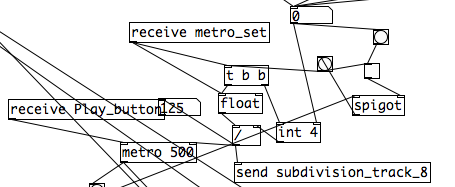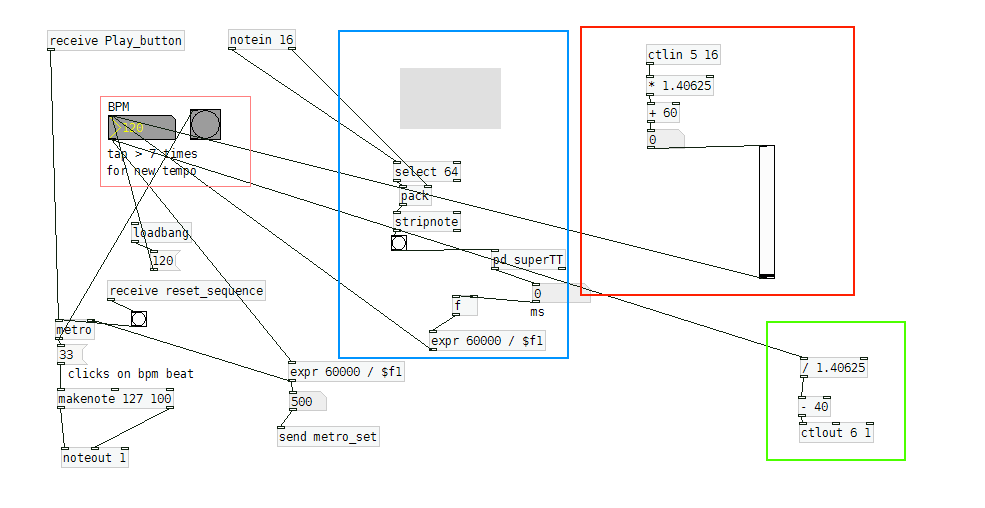Need help to slightly modify a PD project (Rythmboy)
For example, here's what you would have to do to make this patch work. I downloaded the RhythmBoy patch and took a look around. Pretty messy, but I found what the [receive metro_set] is for:
Essentially, it's for determining the subdivision if you ever want to change it. If you are using metro, you need to know the exact bpm in order to do this. Essentially you take your original bpm (let's say 120) and multiply by some number if you want to work with smaller subdivisions. 120*2=240bpm which is eights notes at 120 bpm. 120 * 4 = 480 bpm which is 16th notes at 120 bpm and so forth.
When using [midirealtimein], you have to think about everything backwards. The midi message "Continue" (which you derive your timing info from) is sent at some crazy number like 200 times a second. I'm sure there's someone more knowledgable than me who knows the actual number!
In any case, in order to derive tempo and subdivisions, you simply select how large of a "cycle" you want to represent your beat. This is accomplished with modular arithmetic (aka the [mod] or [% ] objects. So with [midirealtimein], you have to start with your smallest beat division and work from there like so:
In any case, if you want your to modify you patch to be able to sync up eternally, it is definitely possible. It would take a lot of work because you would have to swap out the whole [metro] mechanism for something like the above.
Need help to slightly modify a PD project (Rythmboy)
Hello everyone!
I recently stumbled upon a PuraData based step sequencer for my QuNeo MIDI controller, the so called Rythmboy:
http://subtersonic.weebly.com/blog/rhythmboy-a-step-sequencer-for-kmi-quneo
I want to use it as a step sequencer to use with the remix decks in Traktor, so I can add drums to the tracks I play.
Unfortunately, the Rythmboy has an internal MIDI clock, so I can't sync it with an external clock. I already tried to replace the BPM rotary in the patch with "MIDIrealtimein" and the stuff that's also needed, but I can't get it to work.
I managed to do all the other stuff that is needed to work with Traktor (changing the note output, optically mirroring the rotaries, limiting the notes ranges etc.), so I tried, but I don't know how to work with an external midi clock. Another problem that may occur is that the Rhythmboy then needs two MIDI inputs, #1 is the QuNeo and #2 is the external clock (Traktor or my Xone4D mixer).
This is the part of the Rhythmboy that controls the MIDI clock:

The blue box is a tap button to tap in the tempo. This is not needed.
The red box converts a rotary MIDI input between 0 and 127 into a BPM value between 60 and 240 bpm and gives out that value. This is where the changes need to happen I think. I need something that changes the MIDI clock in into a numerical BPM value.
The green box gives output to the rotary LEDs to show the current BPM. This is also not needed.
The other stuff lets a LED blink a metronome, I think.
So, would one of you please tell me what to put in instead of the red box, to make the magic happen?
Best regards,
Spatz
use of threads for i²c I/O external : looking for a good strategy
@nau Hi, same boat (I don't know much about Pd internal functions & pthread), but maybe you can try to see if this external (really similar to my template, but this time to fetch real data for my HiCu project).
Look for m_clock / m_interval and clock_delay.
// ==============================================================================
// gac.c
//
// pd-Interface to [ 11h11 | gac ]
// Adapted by: Patrick Sebastien Coulombe
// Website: http://www.workinprogress.ca/guitare-a-crayon
//
// Original Author: Michael Egger
// Copyright: 2007 [ a n y m a ]
// Website: http://gnusb.sourceforge.net/
//
// License: GNU GPL 2.0 www.gnu.org
// Version: 2009-04-11
// ==============================================================================
// ==============================================================================
#include "m_pd.h"
#include <usb.h> //http://libusb-win32.sourceforge.net
#include <stdio.h>
#include <stdlib.h>
#include <string.h>
#include "pthread.h"
#include "../common/gac_cmds.h"
// ==============================================================================
// Constants
// ------------------------------------------------------------------------------
#define USBDEV_SHARED_VENDOR 0x16c0 /* VOTI */
#define USBDEV_SHARED_PRODUCT 0x05dc /* Obdev's free shared PID */
#define DEFAULT_CLOCK_INTERVAL 34 /* ms */
#define OUTLETS 11
#define USBREPLYBUFFER 14
unsigned char buffer[USBREPLYBUFFER]; //accessible everywhere
// ==============================================================================
// Our External's Memory structure
// ------------------------------------------------------------------------------
typedef struct _gac // defines our object's internal variables for each instance in a patch
{
t_object p_ob; // object header - ALL pd external MUST begin with this...
usb_dev_handle *dev_handle; // handle to the gac usb device
void *m_clock; // handle to our clock
double m_interval; // clock interval for polling edubeat
double m_interval_bak; // backup clock interval for polling edubeat
int is_running; // is our clock ticking?
void *outlets[OUTLETS]; // handle to the objects outlets
int x_verbose;
pthread_attr_t gac_thread_attr;
pthread_t x_threadid;
} t_gac;
void *gac_class; // global pointer to the object class - so pd can reference the object
// ==============================================================================
// Function Prototypes
// ------------------------------------------------------------------------------
void *gac_new(t_symbol *s);
void gac_assist(t_gac *x, void *b, long m, long a, char *s);
void gac_bang(t_gac *x);
void gac_bootloader(t_gac *x);
static int usbGetStringAscii(usb_dev_handle *dev, int ndex, int langid, char *buf, int buflen);
void find_device(t_gac *x);
// =============================================================================
// Threading
// ------------------------------------------------------------------------------
static void *usb_thread_read(void *w)
{
t_gac *x = (t_gac*) w;
int nBytes;
while(1) {
pthread_testcancel();
if (!(x->dev_handle)) find_device(x);
else {
nBytes = usb_control_msg(x->dev_handle, USB_TYPE_VENDOR | USB_RECIP_DEVICE | USB_ENDPOINT_IN,
EDUBEAT_CMD_POLL, 0, 0, (char *)buffer, sizeof(buffer), DEFAULT_CLOCK_INTERVAL);
if(x->x_verbose)post("thread read %i bytes", nBytes);
//post("%i b", nBytes);
}
}
return 0;
}
static void usb_thread_start(t_gac *x) {
// create the worker thread
if(pthread_attr_init(&x->gac_thread_attr) < 0)
{
error("gac: could not launch receive thread");
return;
}
if(pthread_attr_setdetachstate(&x->gac_thread_attr, PTHREAD_CREATE_DETACHED) < 0)
{
error("gac: could not launch receive thread");
return;
}
if(pthread_create(&x->x_threadid, &x->gac_thread_attr, usb_thread_read, x) < 0)
{
error("gac: could not launch receive thread");
return;
}
else
{
if(x->x_verbose)post("gac: thread %d launched", (int)x->x_threadid );
}
}
//--------------------------------------------------------------------------
// - Message: bootloader
//--------------------------------------------------------------------------
void gac_bootloader(t_gac *x)
{
int cmd;
int nBytes;
unsigned char bootloaderbuffer[8];
cmd = 0;
cmd = EDUBEAT_CMD_START_BOOTLOADER;
if (!(x->dev_handle)) find_device(x);
else {
nBytes = usb_control_msg(x->dev_handle, USB_TYPE_VENDOR | USB_RECIP_DEVICE | USB_ENDPOINT_IN,
cmd, 0, 0, (char *)bootloaderbuffer, sizeof(bootloaderbuffer), DEFAULT_CLOCK_INTERVAL);
}
}
//--------------------------------------------------------------------------
// - Message: bang -> poll gac
//--------------------------------------------------------------------------
void gac_bang(t_gac *x) {
int i,n;
int replymask,replyshift,replybyte;
int temp;
for (i = 0; i < OUTLETS; i++) {
temp = buffer[i];
switch(i) {
case 0:
replybyte = buffer[8];
replyshift = ((0 % 4) * 2);
replymask = (3 << replyshift);
temp = temp * 4 + ((replybyte & replymask) >> replyshift);
break;
case 1:
replybyte = buffer[8];
replyshift = ((1 % 4) * 2);
replymask = (3 << replyshift);
temp = temp * 4 + ((replybyte & replymask) >> replyshift);
break;
case 2:
replybyte = buffer[8];
replyshift = ((2 % 4) * 2);
replymask = (3 << replyshift);
temp = temp * 4 + ((replybyte & replymask) >> replyshift);
break;
case 3:
replybyte = buffer[8];
replyshift = ((3 % 4) * 2);
replymask = (3 << replyshift);
temp = temp * 4 + ((replybyte & replymask) >> replyshift);
break;
case 4:
replybyte = buffer[9];
replyshift = ((0 % 4) * 2);
replymask = (3 << replyshift);
temp = temp * 4 + ((replybyte & replymask) >> replyshift);
break;
case 5:
replybyte = buffer[9];
replyshift = ((1 % 4) * 2);
replymask = (3 << replyshift);
temp = temp * 4 + ((replybyte & replymask) >> replyshift);
break;
case 6:
replybyte = buffer[9];
replyshift = ((2 % 4) * 2);
replymask = (3 << replyshift);
temp = temp * 4 + ((replybyte & replymask) >> replyshift);
break;
case 8:
temp = buffer[10];
replybyte = buffer[13];
replyshift = ((0 % 4) * 2);
replymask = (3 << replyshift);
temp = temp * 4 + ((replybyte & replymask) >> replyshift);
break;
case 9:
temp = buffer[11];
replybyte = buffer[13];
replyshift = ((1 % 4) * 2);
replymask = (3 << replyshift);
temp = temp * 4 + ((replybyte & replymask) >> replyshift);
break;
case 10:
temp = buffer[12];
replybyte = buffer[13];
replyshift = ((2 % 4) * 2);
replymask = (3 << replyshift);
temp = temp * 4 + ((replybyte & replymask) >> replyshift);
break;
}
outlet_float(x->outlets[i], temp);
}
}
//--------------------------------------------------------------------------
// - The clock is ticking, tic, tac...
//--------------------------------------------------------------------------
void gac_tick(t_gac *x) {
clock_delay(x->m_clock, x->m_interval); // schedule another tick
gac_bang(x); // poll the edubeat
}
//--------------------------------------------------------------------------
// - Object creation and setup
//--------------------------------------------------------------------------
int gac_setup(void)
{
gac_class = class_new ( gensym("gac"),(t_newmethod)gac_new, 0, sizeof(t_gac), CLASS_DEFAULT,0);
// Add message handlers
class_addbang(gac_class, (t_method)gac_bang);
class_addmethod(gac_class, (t_method)gac_bootloader, gensym("bootloader"), A_DEFSYM,0);
post("bald-approved gac version 0.1",0);
return 1;
}
//--------------------------------------------------------------------------
void *gac_new(t_symbol *s) // s = optional argument typed into object box (A_SYM) -- defaults to 0 if no args are typed
{
t_gac *x; // local variable (pointer to a t_gac data structure)
x = (t_gac *)pd_new(gac_class); // create a new instance of this object
x->m_clock = clock_new(x,(t_method)gac_tick);
x->x_verbose = 0;
x->m_interval = DEFAULT_CLOCK_INTERVAL;
x->m_interval_bak = DEFAULT_CLOCK_INTERVAL;
x->dev_handle = NULL;
int i;
// create outlets and assign it to our outlet variable in the instance's data structure
for (i=0; i < OUTLETS; i++) {
x->outlets[i] = outlet_new(&x->p_ob, &s_float);
}
usb_thread_start(x); //start polling the device
clock_delay(x->m_clock,0.); //start reading the buffer
return x; // return a reference to the object instance
}
//--------------------------------------------------------------------------
// - Object destruction
//--------------------------------------------------------------------------
void gac_free(t_gac *x)
{
if (x->dev_handle) usb_close(x->dev_handle);
freebytes((t_object *)x->m_clock, sizeof(x->m_clock));
while(pthread_cancel(x->x_threadid) < 0)
if(x->x_verbose)post("gac: killing thread\n");
if(x->x_verbose)post("gac: thread canceled\n");
}
//--------------------------------------------------------------------------
// - USB Utility Functions
//--------------------------------------------------------------------------
static int usbGetStringAscii(usb_dev_handle *dev, int ndex, int langid, char *buf, int buflen)
{
char asciibuffer[256];
int rval, i;
if((rval = usb_control_msg(dev, USB_ENDPOINT_IN, USB_REQ_GET_DESCRIPTOR, (USB_DT_STRING << 8) + ndex, langid, asciibuffer, sizeof(asciibuffer), 1000)) < 0)
return rval;
if(asciibuffer[1] != USB_DT_STRING)
return 0;
if((unsigned char)asciibuffer[0] < rval)
rval = (unsigned char)asciibuffer[0];
rval /= 2;
/* lossy conversion to ISO Latin1 */
for(i=1;i<rval;i++){
if(i > buflen) /* destination buffer overflow */
break;
buf[i-1] = asciibuffer[2 * i];
if(asciibuffer[2 * i + 1] != 0) /* outside of ISO Latin1 range */
buf[i-1] = '?';
}
buf[i-1] = 0;
return i-1;
}
//--------------------------------------------------------------------------
void find_device(t_gac *x) {
usb_dev_handle *handle = NULL;
struct usb_bus *bus;
struct usb_device *dev;
usb_init();
usb_find_busses();
usb_find_devices();
for(bus=usb_busses; bus; bus=bus->next){
for(dev=bus->devices; dev; dev=dev->next){
if(dev->descriptor.idVendor == USBDEV_SHARED_VENDOR && dev->descriptor.idProduct == USBDEV_SHARED_PRODUCT){
char string[256];
int len;
handle = usb_open(dev); /* we need to open the device in order to query strings */
if(!handle){
error ("Warning: cannot open USB device: %s", usb_strerror());
continue;
}
/* now find out whether the device actually is gac */
len = usbGetStringAscii(handle, dev->descriptor.iManufacturer, 0x0409, string, sizeof(string));
if(len < 0){
post("gac: warning: cannot query manufacturer for device: %s", usb_strerror());
goto skipDevice;
}
post("::::::%s", string);
if(strcmp(string, "11h11") != 0)
goto skipDevice;
len = usbGetStringAscii(handle, dev->descriptor.iProduct, 0x0409, string, sizeof(string));
if(len < 0){
post("gac: warning: cannot query product for device: %s", usb_strerror());
goto skipDevice;
}
if(strcmp(string, "Gac") == 0)
break;
skipDevice:
usb_close(handle);
handle = NULL;
}
}
if(handle)
break;
}
if(!handle){
post("Could not find USB device 11h11/gac");
x->dev_handle = NULL;
} else {
x->dev_handle = handle;
post("Found USB device 11h11/gac");
}
}
Cheers
Slice//Jockey presented
hi katja!
i get the following error when opening the zip file for linux:
(ubuntu 10.10 32bit)
Archive: /tmp/SliceJockeyLinux32.zip
[/tmp/SliceJockeyLinux32.zip]
End-of-central-directory signature not found. Either this file is not
a zipfile, or it constitutes one disk of a multi-part archive. In the
latter case the central directory and zipfile comment will be found on
the last disk(s) of this archive.
zipinfo: cannot find zipfile directory in one of /tmp/SliceJockeyLinux32.zip or
/tmp/SliceJockeyLinux32.zip.zip, and cannot find /tmp/SliceJockeyLinux32.zip.ZIP, period.
i tried several times...
i think its broken
and id really like to play with it...
8-(
oh
AWsome work bytheway
Puzzle from Johannes Kreidler's book
hello, im studying pure data on Johannes Kreidler's book Programming Electronic music with PD and ive made almost all the exercises of chapter one and now im stuck and i want to go to the next chapter but im stuck on this one.
Im suppossed to create a metronome that beats 5 times on 60 bpm and then 5 times on 100 bpm.
i start the patch and it beats 5 times on 60 bpm like its suppossed and then when its time to change to 100 bpm and beat just 5 times it gets stuck on beating at a 100 and i cant make it change to 60 bpm again by itself and have a nice loop beating 5 times and 5 times on each bpm.
i know this is a pretty stupid question and patch but id love if you could help me out to understand what am i missing, ive been trying for almost 5 hours... 
ive attached what i have so far.
HELP!
http://www.pdpatchrepo.info/hurleur/5_times_60pm_5_times_100_bpm.pd
Interaction Design Student Patches Available
Greetings all,
I have just posted a collection of student patches for an interaction design course I was teaching at Emily Carr University of Art and Design. I hope that the patches will be useful to people playing around with Pure Data in a learning environment, installation artwork and other uses.
The link is: http://bit.ly/8OtDAq
or: http://www.sfu.ca/~leonardp/VideoGameAudio/main.htm#patches
The patches include multi-area motion detection, colour tracking, live audio looping, live video looping, collision detection, real-time video effects, real-time audio effects, 3D object manipulation and more...
Cheers,
Leonard
Pure Data Interaction Design Patches
These are projects from the Emily Carr University of Art and Design DIVA 202 Interaction Design course for Spring 2010 term. All projects use Pure Data Extended and run on Mac OS X. They could likely be modified with small changes to run on other platforms as well. The focus was on education so the patches are sometimes "works in progress" technically but should be quite useful for others learning about PD and interaction design.
NOTE: This page may move, please link from: http://www.VideoGameAudio.com for correct location.
Instructor: Leonard J. Paul
Students: Ben, Christine, Collin, Euginia, Gabriel K, Gabriel P, Gokce, Huan, Jing, Katy, Nasrin, Quinton, Tony and Sandy
GabrielK-AsteroidTracker - An entire game based on motion tracking. This is a simple arcade-style game in which the user must navigate the spaceship through a field of oncoming asteroids. The user controls the spaceship by moving a specifically coloured object in front of the camera.
Features: Motion tracking, collision detection, texture mapping, real-time music synthesis, game logic
GabrielP-DogHead - Maps your face from the webcam onto different dog's bodies in real-time with an interactive audio loop jammer. Fun!
Features: Colour tracking, audio loop jammer, real-time webcam texture mapping
Euginia-DanceMix - Live audio loop playback of four separate channels. Loop selection is random for first two channels and sequenced for last two channels. Slow volume muting of channels allows for crossfading. Tempo-based video crossfading.
Features: Four channel live loop jammer (extended from Hardoff's ma4u patch), beat-based video cross-cutting
Huan-CarDance - Rotates 3D object based on the audio output level so that it looks like it's dancing to the music.
Features: 3D object display, 3d line synthesis, live audio looper
Ben-VideoGameWiiMix - Randomly remixes classic video game footage and music together. Uses the wiimote to trigger new video by DarwiinRemote and OSC messages.
Features: Wiimote control, OSC, tempo-based video crossmixing, music loop remixing and effects
Christine-eMotionAudio - Mixes together video with recorded sounds and music depending on the amount of motion in the webcam. Intensity level of music increases and speed of video playback increases with more motion.
Features: Adaptive music branching, motion blur, blob size motion detection, video mixing
Collin-LouderCars - Videos of cars respond to audio input level.
Features: Video switching, audio input level detection.
Gokce-AVmixer - Live remixing of video and audio loops.
Features: video remixing, live audio looper
Jing-LadyGaga-ing - Remixes video from Lady Gaga's videos with video effects and music effects.
Features: Video warping, video stuttering, live audio looper, audio effects
KatyC_Bunnies - Triggers video and audio using multi-area motion detection. There are three areas on each side to control the video and audio loop selections. Video and audio loops are loaded from directories.
Features: Multi-area motion detection, audio loop directory loader, video loop directory loader
Nasrin-AnimationMixer - Hand animation videos are superimposed over the webcam image and chosen by multi-area motion sensing. Audio loop playback is randomly chosen with each new video.
Features: Multi-area motion sensing, audio loop directory loader
Quintons-AmericaRedux - Videos are remixed in response to live audio loop playback. Some audio effects are mirrored with corresponding video effects.
Features: Real-time video effects, live audio looper
Tony-MusicGame - A music game where the player needs to find how to piece together the music segments triggered by multi-area motion detection on a webcam.
Features: Multi-area motion detection, audio loop directory loader
Sandy-Exerciser - An exercise game where you move to the motions of the video above the webcam video. Stutter effects on video and live audio looper.
Features: Video stutter effect, real-time webcam video effects
VisualTracker - request for participants
Here is some more info:
This is development info of VisualTracker for pd (pre alpha 100404)
What is it:
VisualTracker is sample sequencer – it triggers loaded samples in times defined in time line in editor window. Samples can be played in their default speed / length or can be fitted in tempo. In “fit mode” you can define number of bars to fit in and also multiplication of file. All changes have visual interpretation in sample canvases.
VisualTracker for pd (pre alpha 100404) was developed in Pd version 0.41.4-extended, on Windows XP
How to make it work:
- Open VisualTracker_(pre_alpha_100404).pd in pd.
- Editor and Samples window are automatically opened.
- Preset currentstate.vtp is automatically loaded – this preset is saved before closing the patch.
- After first run there are 3 empty sample boxes in samples window and 3 corresponding sample canvases in editor window.
- Load any wav (44100 Hz) by pressing „load“ in selected sample box. No space characters in path or filename are allowed. Loading of these files is aborted and error message appears for several seconds. Name of the successfully loaded sample including full path appears in sample box and also sample canvas in editor window. Size of sample canvas is changed according to the sample length. Try to change global BPM – size of sample canvas is recalculated.
- Check „fit“ to fit sample in current BPM. Set length of sample in bars and multiplication.
- Add another sample by creating object [sample] or just copy existing sample box in samples window.
- Switch to editor window, press CTRL+E to switch to pd edit mode and drag and drop sample canvases to desired position on time line. Sample canvases are automatically snapping to bar columns and rows.
- Switch back to normal mode by CTRL+E
- Press PLAY to replay your sample composition. Samples are played only if corresponding sample canvas is placed in track 1-6. If sample canvas is above the tracks sound is muted.
- Press „save“ in main VisualTracker window to save current preset to a text file. Any name and extension with no spaces is allowed.
- Before closing VisualTracker press „save state & close“. It saves current state to preset named currentstate.vtp and delete all sample boxes from samples window and all sample canvases from editor window. Now you can turn off and eventually save VisualTracker patch. This is important to avoid double appearance of sample canvases because information about samples and composition is stored independently from pd patch and should not be saved inside patch. If there are still some „orphaned“ sample canvases hanging delete them manually.
Components:
- Sample window: place for unlimited amount of [sample] abstractions. Once abstraction is created (by copying or creating the object) corresponding sample canvas is created in editor window. [sample] abstraction is sending data to sample canvas (name, color, size, snapping) and receiving back position. Triggering of sample playback is based on position of sample canvas.
- Editor window: place for sample canvases composition on the top of timeline grid. Sample canvases can be moved by mouse in pd edit mode (CTRL+E). Timeline grid will be extended and improved in next versions.
- Preset save/load: saves and loads presets to/from a text file using [coll] object. Preset contains global values (number of samples in composition, bpm) and local values for each sample box (filename, position, track, multiplication, number of bars, fit switch, color and two unused values).
- Sequencer: located in program subpatch. Very simple - functionality will be extended and improved in next versions
- Other: located in program subpatch. Contains some other patches as colortable, BPM manager, output etc.
How do I go about....
oh and if you did manage to find an OSC output from the liveOSC scripts, you would then need to call your LED the same as the OSC command from live, or you would need to reformat the command from live using puredata to that of the LED.
e.g. if LiveOSC has an OSC send called /live/tempo/beat (I doubt it does) then you would have LiveOSC script connect to your TouchOSC, and the LED would be also /live/tempo/beat.
It may be that even if there's no way to send OSC tempo beat messages from Live using the liveosc script, you could maybe use live to map the beat to move a controller, and send this information to puredata where you could reformat it.
I just checked http://github.com/willrjmarshall/AbletonDJTemplate/blob/44609dbd1be136d517c420f14fc987e9aa96fcc6/TouchOSCTemplate/LiveOSC/OSCAPI.txt
There isn't anything that will solely broadcast beats over OSC, but there are a couple of things that with some puredata manipulation might be able to do this:
live/tempo = Request current tempo, replies with /live/tempo (float tempo)
/live/tempo (float tempo) = Set the tempo, replies with /live/tempo (float tempo)
/live/time = Request current song time, replies with /live/time (float time)
/live/time (float time) = Set the time , replies with /live/time (float time)
It might (just) be possible to write code to examine the song tempo, examine regularly the song time and from there calculate when the beat will drop. I'm not about to start on this any time soon but there is the potential to do this. The amount of work might be offset by actually monitoring the metronome, or just listening to the music to get an idea where the bars are ;o)
Just guesses but good luck with it, I want to do similar as I'm working on a full remote DJ tool for TouchOSC (clip browser and selecter, tempo, monitoring, mixer, xfader, effects and filters). I'm using puredata for this, touchOSc and the l;iveOSC remote scripts. I tested all the theoretical bits for this and have it working, just need to but the behemoth PD together to handle it all! Oh, and another feature will be a toggle on the accelerometer to control any effect, fader etc so "put your hands in the air" and "drop the bass" will be actually doable! Of course, the main reason I want this is I like the music I spin and I'm sick of being stuck behind sensitive equipment where I can't dance properly 
Conways Life
I don't know "conway's game and youtube is blocked here by the authorities... so I'm playing around with your patch, nicely done.
There seems to be a problem with your tempo though - is it that you take [metro] to be tempo? in that event, you have millisecs instead of tempo, the higher your tempo value the slower the tempo... if you add an [expr 1000/$f1/60)] your tempo would appear as bpm. If that is what you want, of course.
Frank Barknecht's Collision-detection patch
hi all, doing a little 2d collision detection here very simple and i found frank' patch here: [html]http://www.mail-archive.com/pd-list@iem.at/msg06087/collision-detection.pd[/html]
if you run the patch asis, the collision detection occurs only when the middle of the smaller circle hits the outside of the bigger circle...
i can see the variable the changes this.
i.e. i want the collision detection to occur when the outside of the smaller circle hits the outside of the bigger circle.
if im not clear i can attempt a rephrase, but any help on this matter would be greatly appreciated...
im sure its a number box somewhere but i cant see where 
thank you.



